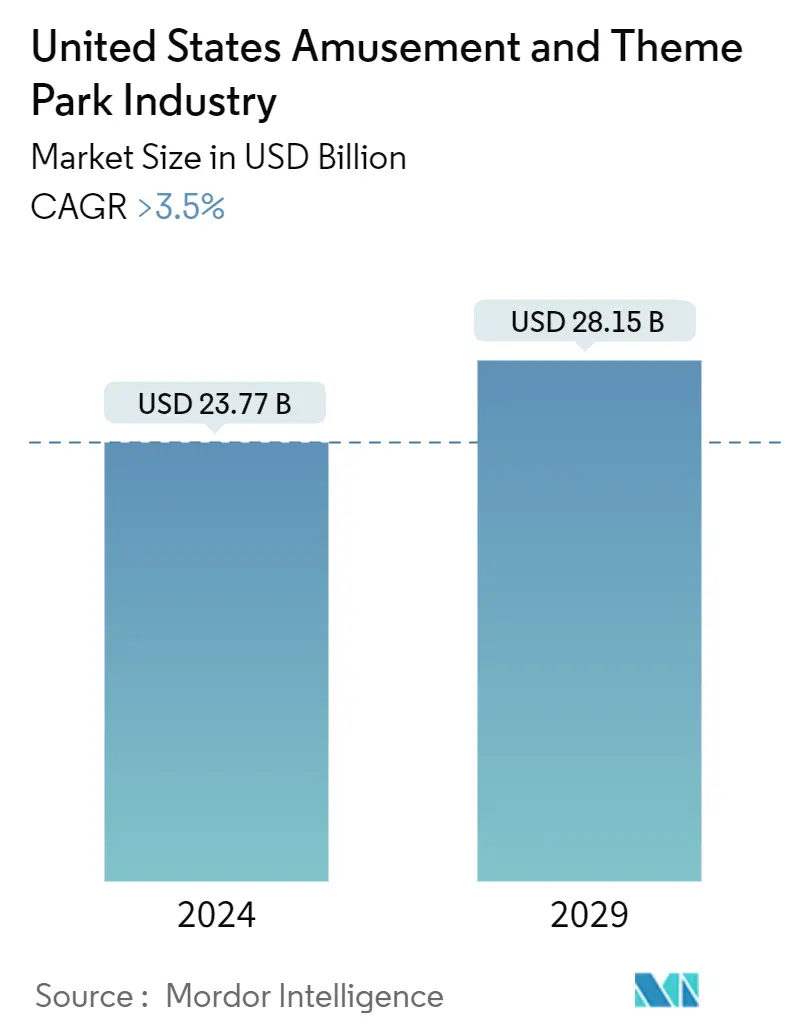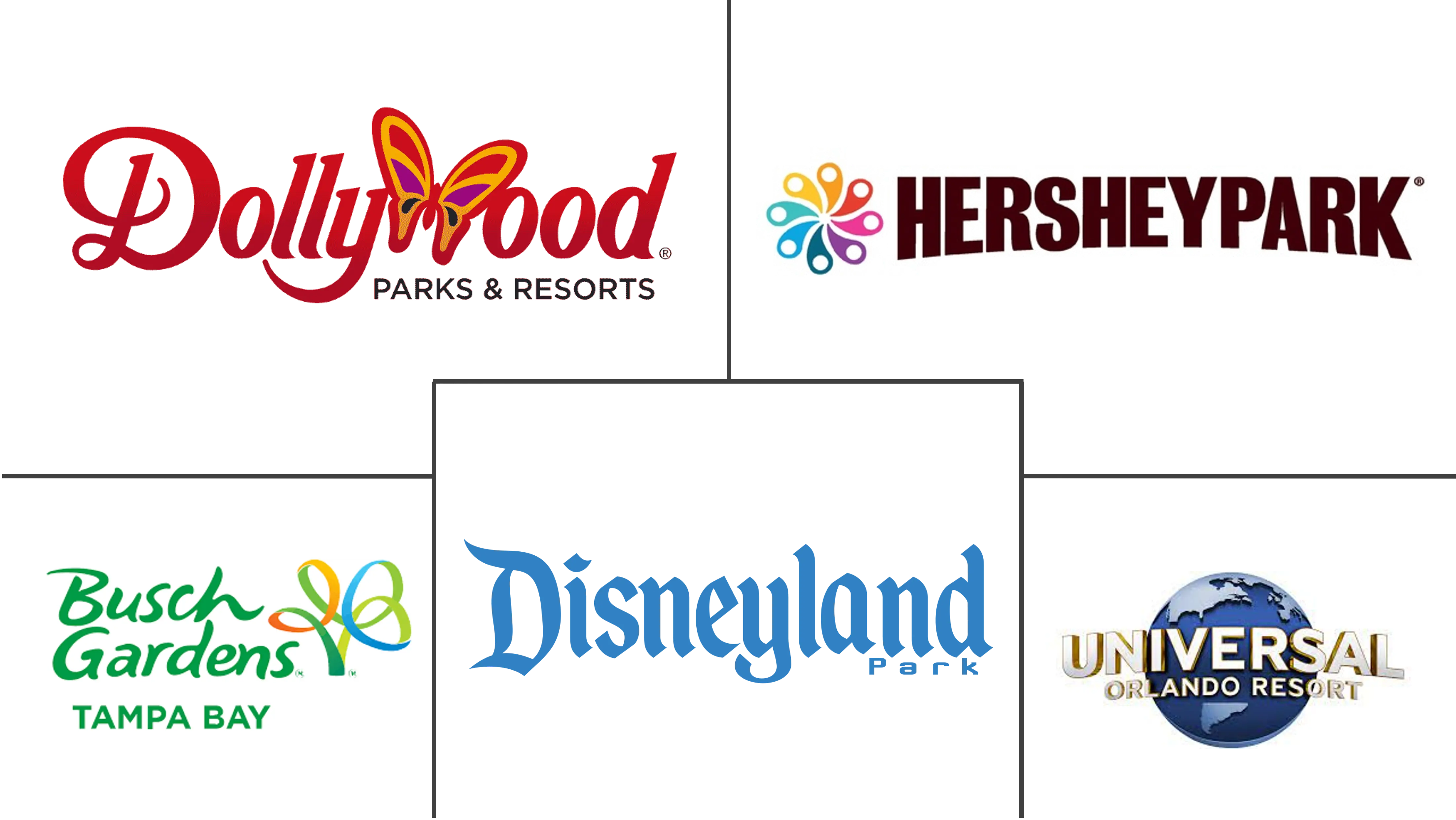Market Size of United States Amusement And Theme Park Industry

| Study Period | 2020-2029 |
| Base Year For Estimation | 2023 |
| Market Size (2024) | USD 23.77 Billion |
| Market Size (2029) | USD 28.15 Billion |
| CAGR (2024 - 2029) | 3.50 % |
| Market Concentration | Low |
Major Players
*Disclaimer: Major Players sorted in no particular order |
US Amusement and Theme Parks Market Analysis
The United States Amusement And Theme Park Industry is expected to grow from USD 23.77 billion in 2024 to USD 28.15 billion by 2029, at a CAGR of greater than 3.5% during the forecast period (2024-2029).
The market growth is a result of the increasing adoption of technological advancements in the form of augmented and virtual reality. The inculcation of advanced motion simulators, hydraulics, and pneumatics, along with the focus on customers’ experience, is expected to increase the market demand in the coming years. In recent years, more theme parks have begun to incorporate advanced technology into their rides and displays to enhance their experiences. The competition within the industry has increased with the introduction of AR & VR gaming centers, live concerts, and movie theatres that require comparatively less time and ensure a great experience.
In the United States, many theme parks have competed for the right to incorporate intellectual property from popular movies and television productions into their entertainment. Disneyland, for instance, has often relied on animated characters designed by Walt Disney. The Chinese tourists, overall, are the third-largest source of overseas tourism after the UK and Japan to the United States, of which around 47% prefer to visit the amusement parks as their prime location.
The theme park business peaked in 2019, the year before the COVID-19 virus forced several parks and attractions to close for a while before reopening with visitation limitations. Additionally, the theme parks discovered methods to extend the dates of popular special events like Halloween celebrations at Universal, Six Flags, and Cedar Fair parks, which drew local tourists. Travel restrictions during the height of the epidemic reaction impacted the domestic visitor sector, which drove attendance in Orlando, Florida, the theme park capital of the United States.
US Amusement and Theme Parks Industry Segmentation
An amusement park is a type of theme park that features a variety of attractions, such as rides, games, and other activities. Amusement parks are distinct from theme parks, which focus their buildings and attractions around a single theme and often have multiple regions with different themes. The United States amusement and theme park industry is segmented by type (land rides, water rides, and other types) and by source of revenue (tickets, food and beverages, merchandise, and other sources of revenue).
The report offers market size and forecasts for the United States Amusement & Theme Park Industry in value (USD) for all the above segments.
| By Type | |
| Land Rides | |
| Water Rides | |
| Other Types |
| By Source of Revenue | |
| Tickets | |
| Foods & Beverages | |
| Merchandise | |
| Hospitality | |
| Other Source of Revenues |
United States Amusement And Theme Park Industry Size Summary
The United States Amusement and Theme Park Industry is poised for significant growth over the forecast period, driven by the integration of advanced technologies such as augmented and virtual reality. This technological adoption is enhancing customer experiences through sophisticated motion simulators and other innovations, thereby boosting market demand. The industry has seen increased competition with the emergence of AR and VR gaming centers, live concerts, and movie theaters, which offer quick and engaging experiences. Theme parks are also competing for the incorporation of popular intellectual properties from movies and television, with major players like Disneyland leveraging animated characters to attract visitors. The industry is recovering strongly from the pandemic's impact, with major parks like Disney and Universal experiencing a resurgence in attendance and spending, as consumers increasingly prioritize experiential travel.
The market landscape is characterized by a fragmented structure, with a small number of companies holding a significant share. These companies are focusing on acquiring intellectual properties cost-effectively and creatively utilizing underutilized IPs to gain a competitive edge. The rise of social media marketing and technological advancements are driving demand for personalized experiences in itinerary planning and bookings. The industry's growth is further supported by changing consumer lifestyles and the experience economy, where individuals are willing to spend on unique, personalized experiences. This trend is particularly appealing to corporate professionals seeking quality time in family-friendly environments. The market's expansion is also influenced by the increasing acceptance of a holistic lifestyle that blends work and leisure, contributing to the overall revenue growth of amusement and theme parks in the United States.
United States Amusement And Theme Park Industry Market Size - Table of Contents
-
1. MARKET DYNAMICS
-
1.1 Market Overview
-
1.2 Market Drivers
-
1.2.1 The number of baby-boomer tourists is expected to increase, which will fuel the growth of the worldwide amusement park market.
-
1.2.2 Incorporating energy-saving innovations like LED lighting and solar panels
-
-
1.3 Market Restraints
-
1.3.1 Theme parks are raising admission costs and letting guests ride every ride without waiting in queue
-
1.3.2 Theme parks utilising virtual reality are becoming more and more common.
-
-
1.4 Market Opportunities
-
1.4.1 Blockchain and virtual assistants are being used more and more.
-
1.4.2 New technological advances are being driven by labour shortages and growing security concerns.
-
-
1.5 Porter's Five Forces Analysis
-
1.5.1 Bargaining Power of Suppliers
-
1.5.2 Bargaining Power of Buyers/Consumers
-
1.5.3 Threat of New Entrants
-
1.5.4 Threat of Substitute Products
-
1.5.5 Intensity of Competitive Rivalry
-
-
1.6 Impact of COVID-19 on the market
-
1.7 Insights on Revenue Flows from Accommodation and Food and Beverage Sectors
-
-
2. MARKET SEGMENTATION
-
2.1 By Type
-
2.1.1 Land Rides
-
2.1.2 Water Rides
-
2.1.3 Other Types
-
-
2.2 By Source of Revenue
-
2.2.1 Tickets
-
2.2.2 Foods & Beverages
-
2.2.3 Merchandise
-
2.2.4 Hospitality
-
2.2.5 Other Source of Revenues
-
-
United States Amusement And Theme Park Industry Market Size FAQs
How big is the United States Amusement And Theme Park Industry?
The United States Amusement And Theme Park Industry size is expected to reach USD 23.77 billion in 2024 and grow at a CAGR of greater than 3.5% to reach USD 28.15 billion by 2029.
What is the current United States Amusement And Theme Park Industry size?
In 2024, the United States Amusement And Theme Park Industry size is expected to reach USD 23.77 billion.

